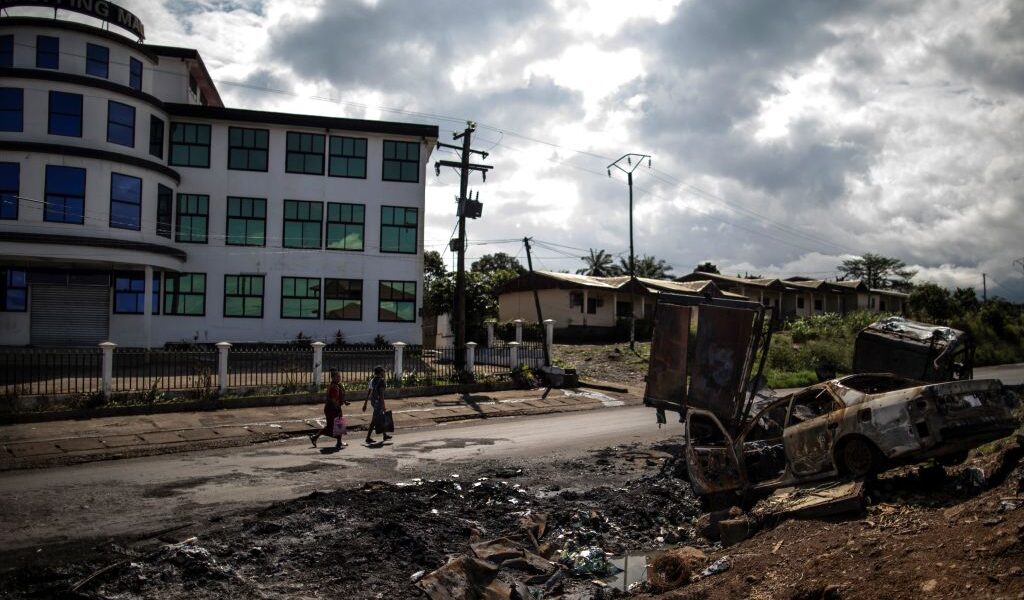Women walk by the edge of an abandoned market in Cameroon’s Southwest region. The Anglophone area has been home to a protracted conflict between separatists and government forces which has led to school closures, displacement and economic damage. AFP/GETTY IMAGES
As children prepared to return to school in Cameroon, a wave of violence swept through the Northwest and Southwest regions, sparking fears of a worsening conflict.
The surge in fighting began in August, when separatists from the Anglophone region warned the government not to reopen schools, as scheduled, in September. What followed has been a series of bombings, kidnappings and attacks, including rape. On September 19, a bomb blast at a market in Bamenda killed one and injured six, including a baby. Separatists said the violence was intended to enforce a lockdown in the Northwest regional capital.
“The situation is becoming very difficult,” veteran Cameroonian journalist Moki Edwin Kindzeka told Africa Defense Forum. “As we speak, there are no less than 3,000 schools that are still sealed, and the separatists have said these schools are not going to be operational. When you don’t allow students to go to school, which is a fundamental human right, it is a serious problem.”
The conflict dates to 2016 and 2017, when the government cracked down on a protest by Anglophone lawyers and teachers who claimed discrimination by the French-speaking majority. Fighters from Cameroon’s English-speaking regions launched attacks against government targets with the goal of establishing a breakaway republic known as Ambazonia. The conflict has displaced 800,000 people and caused the deaths of an estimated 6,000.
The violence also created a lawless environment where both armed gangs and separatists use kidnapping as a source of income or to add to their ranks. Insecurity has paralyzed the regional economy which relies on the palm oil, rubber and banana industries. The fighting is spilling across porous borders into neighboring Nigeria, where there are fears of an Anglophone partnership with Biafran separatists.
Kindzeka said the recent level of violence is actually slightly lower than it was several years ago, but he said both sides appear deeply entrenched in their positions. “When I speak to the separatist leaders, they say they will only stop attacking if the government orders its troops to leave the English-speaking region. The government insists it will never do that,” he said. “So it would be very difficult to see that this problem will be resolved in the years ahead.”
Kindzeka identified several key areas that must be resolved in order to bring about peace.
Product
First, go with the obvious: any eye shadow labeled wet-to-dry. The Nars Dual-Intensity line is the standout—the singles come in 12 different shimmery shades, and there’s a corresponding brush (then there’s the newly released Dual Intensity Blush line, which was all over Fashion Week—but that’s a product for another post). Burberry also makes a few very versatile shades specifically for this in their Wet & Dry Silk Shadows. And the technique-specific eye shadow category isn’t just a ploy to get you to buy more product. “You can’t just use any eye shadow for this,” Vincent says. “Certain ones will harden up on top and become unusable because they’re not made for this.”
Baked shadows are also fair game—we’re fans of Laura Mercier’s Baked Eye Colour Wet/Dry and Lorac’s Starry-Eyed Baked Eye Shadow Trio in particular.
For more advanced players, Vincent suggests moving on to straight pigment (MAC or even OCC’s Pure Cosmetic Pigments). With the added moisture, they’ll become easier to layer with other products. For a look with more depth, try using a cream shadow as a based before swiping with a wet powder shadow. “It’s like insurance,” Vincent says. “You’re doubling your wearability.”
Language parity:
Although Cameroon is nominally a bilingual country, in practice higher education textbooks, exams and lectures are overwhelmingly in French. The same is true in the upper levels of government and military. A 2017 review of political ministers found that 36 of 37 were French speakers and found many of the country’s laws and regulations were not translated into English. This lack of linguistic access is a source of anger among the Anglophone population.
Economic investment: The Anglophone area has some of the highest levels of poverty in the country despite being home to natural resources such as timber, oil and rich agricultural land. Kindzeka said the lack of economic opportunities makes it easy for armed groups to recruit fighters. “When separatists come and propose to give them $100 a month or $200 a month, they will be ready to go and fight,” he said. “So if jobs are not created, it will be very difficult.”
Regional autonomy: Cameroon ceased being a federal country in 1972 and its current system of government means many of the decisions for its 10 regions are made by the central government in the capital, Yaoundé. In 2019, as the Anglophone crisis unfolded, Cameroon’s parliament gave the Northwest and Southwest regions “special status” and more autonomy to control local affairs, but observers say regional autonomy has not been fully enacted.
Dialogue: In 2019, Cameroonian President Paul Biya held a “Major National Dialogue” which included separatist groups and was aimed at resolving the crisis. Observers believe it is now time to revisit some of the grievances brought up during those meetings and hold new dialogue sessions in order to negotiate the terms of peace.
Photographed by Tom Newton.


Hello!
Hello This is testing